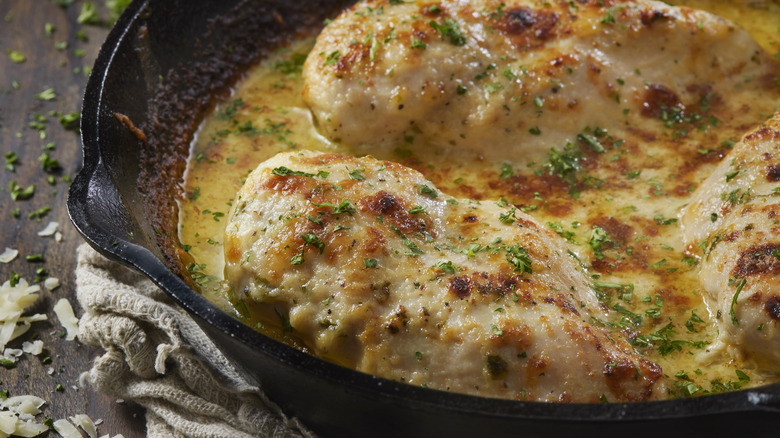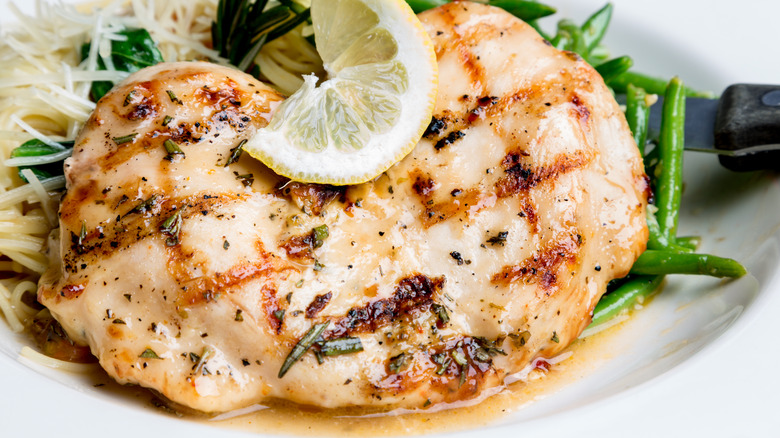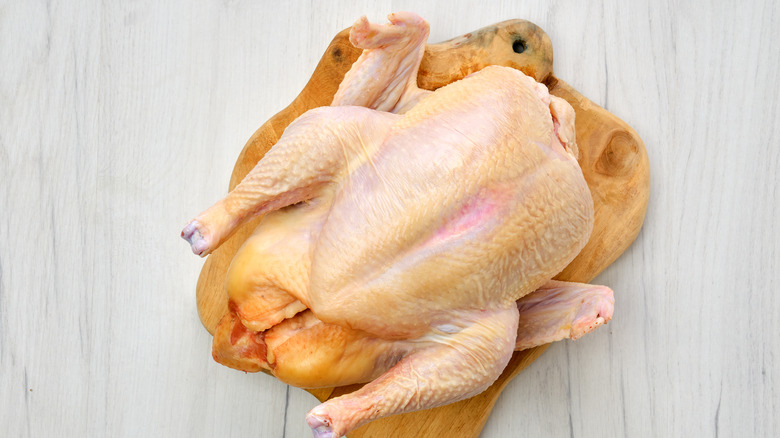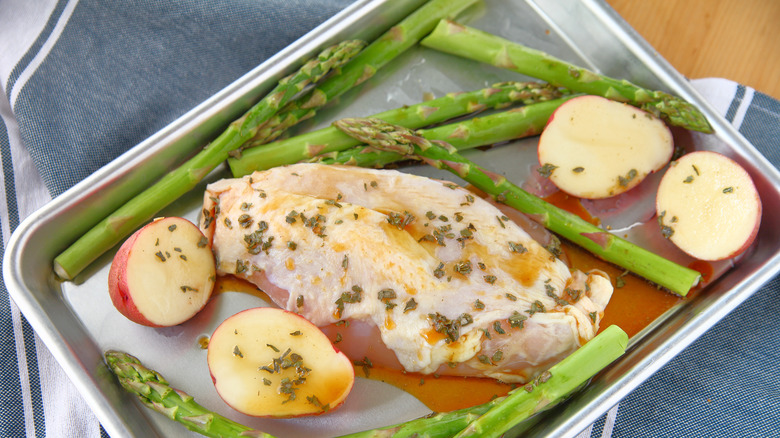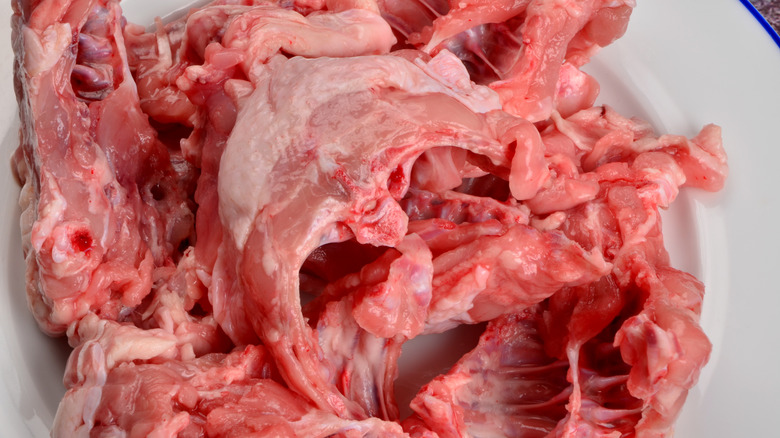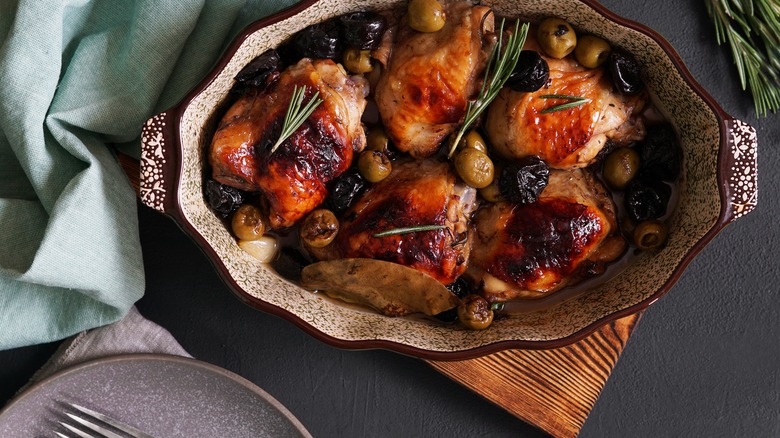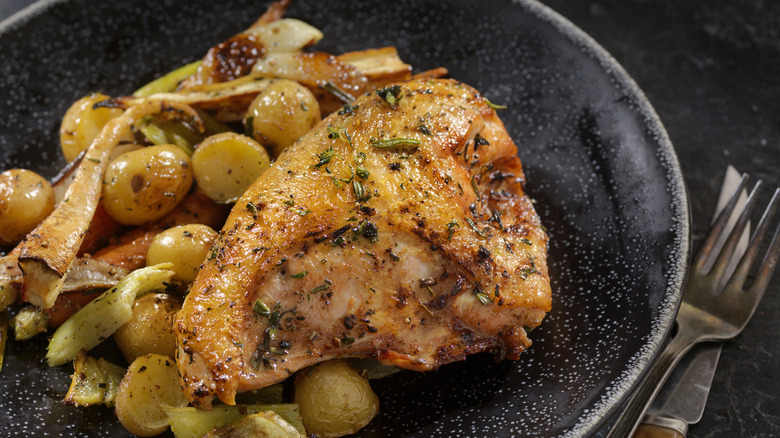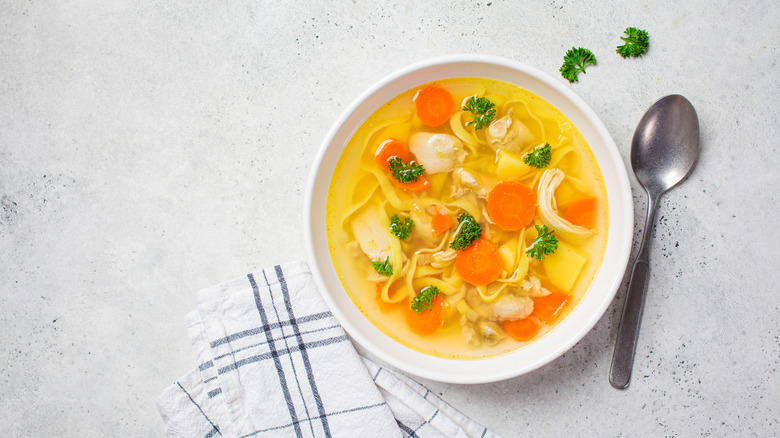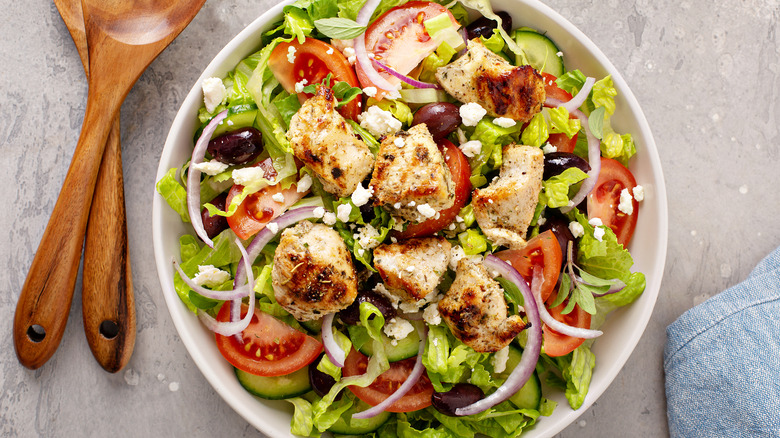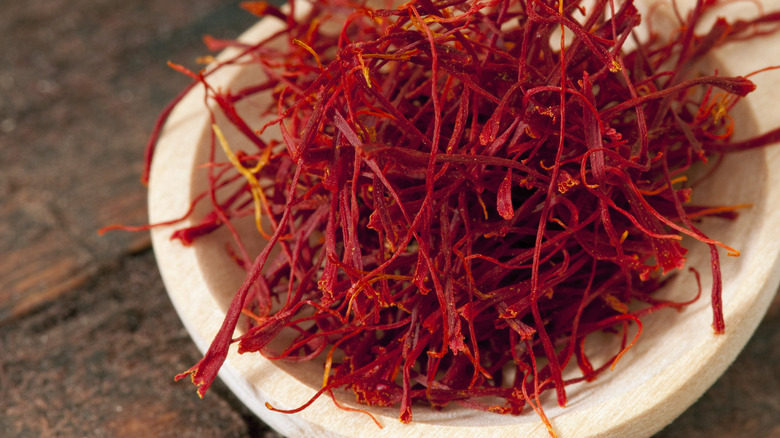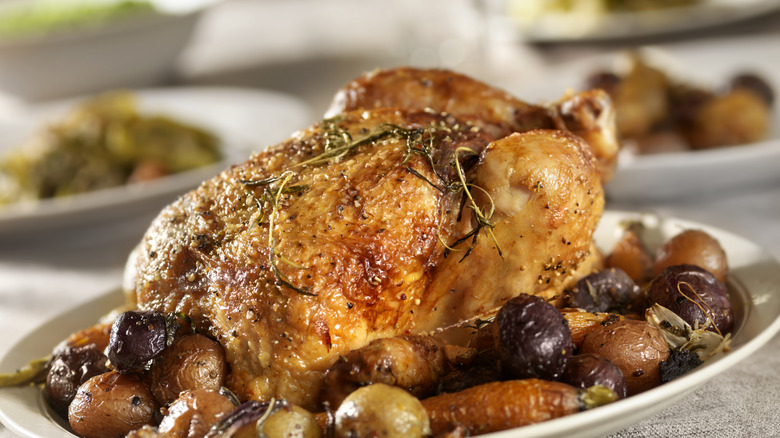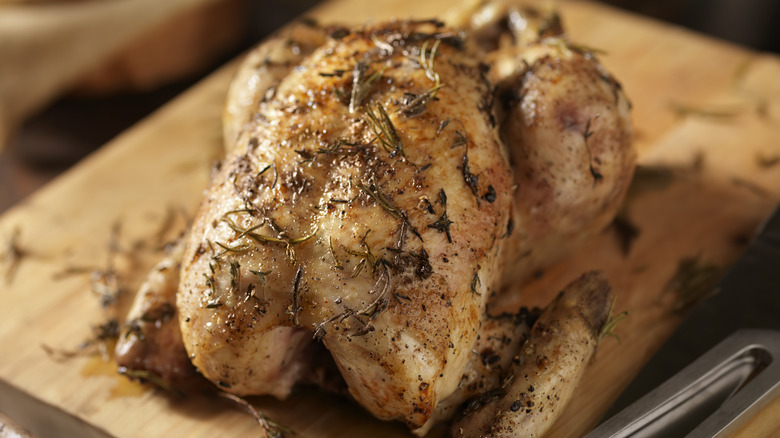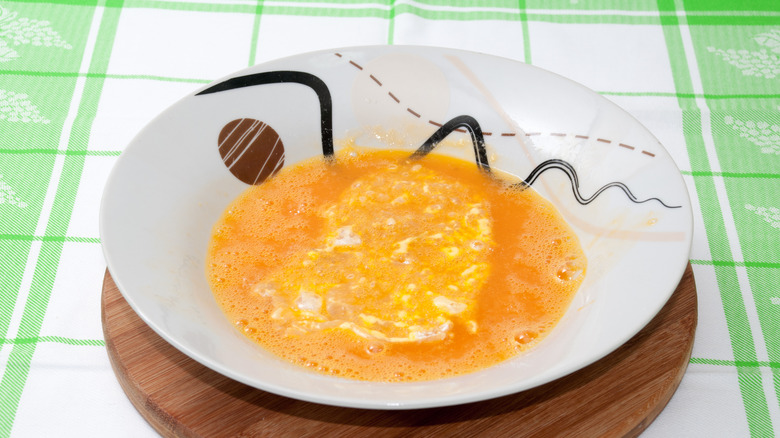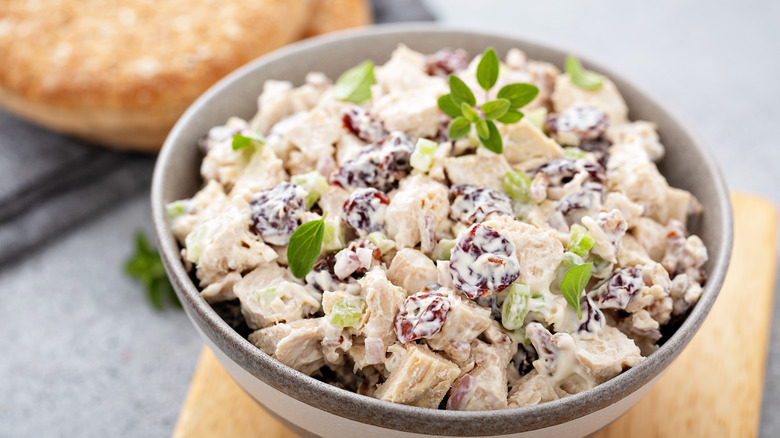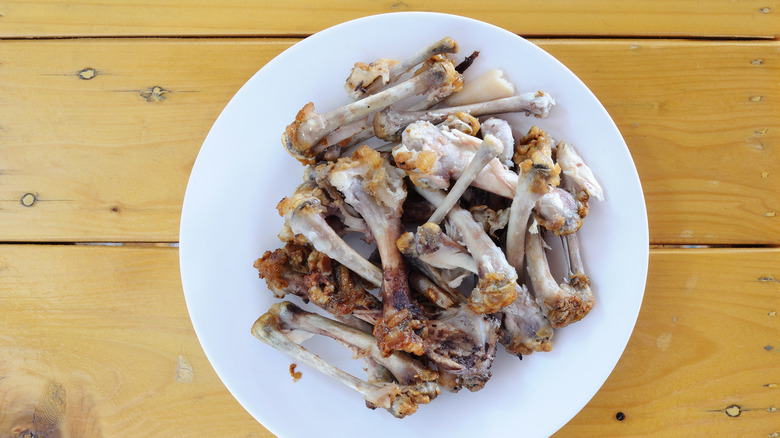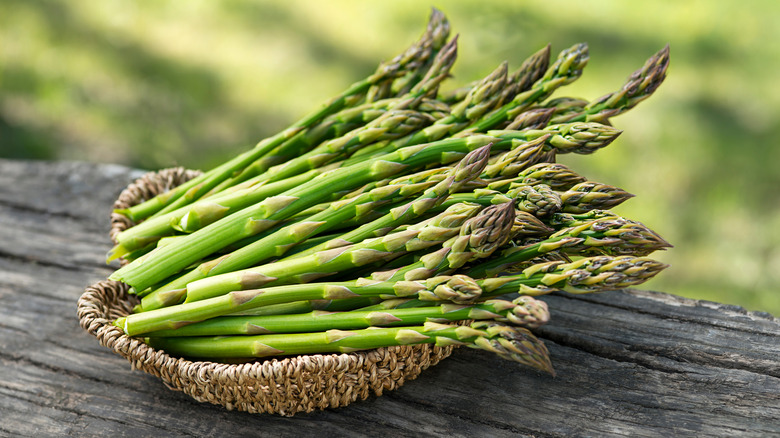Ina Garten's 16 Best Tips For Cooking Chicken
Ina Garten is no stranger to the kitchen. After a career working in nuclear energy policy, Garten moved to the Hamptons in Long Island, New York, and purchased The Barefoot Contessa, a small specialty foods store that sold an array of breads, salads, and ready-made dinner options. Garten grew the business, sold it to her employees, and began a new venture: Becoming a food media mogul and writing cookbooks. Over her career, she's written 13 cookbooks and starred on her Food Network show, "Barefoot Contessa," where she shares her favorite recipes and tips for home cooks worldwide.
One of the most common ingredients that appears in the recipes Garten shares with her adoring fan base, whether on her social media, television show, or cookbooks, is chicken. This star protein is flavorful and the base of many of Garten's most famous dishes, including her engagement roast chicken. With a few simple tips from the Barefoot Contessa, you too can make delicious chicken in your home kitchen. Here are some of our favorite tips from the Food Network star on how to prepare the best bird.
Pour sauce around the chicken, rather than over it
Ina Garten loves adding sauce to her chicken — whether it's her recipe for her internet-famous engagement chicken or skillet-roasted lemon chicken recipe. But, the Barefoot Contessa has some strong opinions about adding sauce to her chicken. Instead of pouring her sauce directly on the chicken, Ina Garten always pours sauce around the chicken.
The primary reason she employs this method is to avoid washing off all the seasoning and crust she puts on her bird. This is an especially important trick for when she cooks with a wine-based sauce, which can, quite literally, wash away all of her hard work. If the sauce contains an acid, it can also prevent the roasted bird from developing the quintessential crispy texture and golden hue that it's known for. When the sauce is added to the pan, the meat can slowly soak it up and develop its flavor without disturbing any of the seasonings.
Add a citrus element before serving
Ina Garten is always looking for ways to boost the flavor of her meals. And the addition of flavorful ingredients doesn't just stop during the cooking process. She adds citrus to roast chicken right before serving to brighten it up rather than letting the flavor turn bitter as it cooks. She also pairs the brightness of the lemon juice with a bit of citrus zest to amp up the tart flavor. It's the key to her favorite roast chicken with lemon and thyme, made with butterflied chicken and her favorite citrus fruit.
Ina Garten also has tips for preventing your lemon from getting too bitter. Her secret method to prevent bitter lemon rinds is to always cut the lemon thinly — no more than ¼ inch thick. This allows the lemon to retain its sweet flavor as it cooks down and caramelizes. You can also remove the seeds to ensure your fruity chicken dish has a perfectly balanced flavor.
Go for a smaller bird
The options for buying a whole chicken can be a bit daunting. Ina Garten suggests you should always choose the smallest chicken because they roast easier than larger birds. She recommends home cooks keep their birds under five pounds for a better flavor. Garten also suggests buying several smaller chickens rather than one massive one if you're cooking for a crowd. There is some science behind choosing the smaller chicken. Older, larger birds have more muscle development, which can make the meat tougher. The selective breeding of large chicken species that reach maturity fast also creates a less flavorful bird that doesn't have the same texture as a smaller one.
Even if your recipe only requires chicken thighs or breast meat, there are countless benefits of buying a whole chicken rather than parts. It's often cheaper, you can use the rest of the bird for your meal prep and keep the carcass around to make homemade stock. Just remember to keep it on the small side.
Use a half-sheet pan for roasting chicken
Ina Garten keeps her kitchen well-stocked with the tools and ingredients she needs to entertain — and make regular weeknight meals for her and her husband, Jeffrey. Her go-to roasting pan for her famous engagement chicken is a half-sheet pan. This recipe has become a dish so good that it's rumored to have inspired marriage proposals, so Garten must be doing something right.
While most recipes require a roasting pan, this half-sheet pan is critical to creating the perfect crispy texture and golden crust on the outside of her bird. The short sides of the pan increase the amount of heat that can circulate around the bird. A conventional roasting plan blocks the heat from being able to move and cook the chicken evenly on all sides. Plus, this pan is easy to clean if you opt to line it with parchment paper or aluminum foil.
Save your carcass leftovers for stock
It's no surprise that food waste is a problem in many home kitchens. Ina Garten has a way of repurposing chicken carcasses that both cuts down on waste and keeps chicken stock in her freezer at all times. Not only does she use the chicken stock to make her favorite chicken soup, but she also uses it as a flavor enhancer for casseroles, pasta dishes, and meat dishes.
Although boxed stock works when you don't have any room left in your freezer or time to make your own DIY stock, it's a worthwhile experience that will improve the flavor of your cooking. She saves her stock in heavy-duty freezer bags so she can easily pull out pieces and defrost them as needed.
Get extra fruity with your chicken Marbella
Ina Garten has been known to take the flavors in her dishes a step beyond what's required. For her chicken Marbella, a fruity vintage chicken dish, she adds extra produce to the original recipe published in "The Silver Palate Cookbook." For example, she adds 1½ cups of prunes instead of a single cup and doubles the amount of pitted green olives.
In addition, she uses a whole head and a half of garlic in her marinade — which is enough to drive vampires away for the foreseeable future. The Barefoot Contessa also maximizes the flavors in her recipe by letting the chicken rest covered with foil to soak up the juice and the fruity essence of her ingredient upgrades.
Leave the skin on
Skin on or skin off? It's a question that has puzzled poultry cooks for a very long time. Ina Garten almost always cooks chicken with the skin on because she believes it locks in the moisture and keeps the meat soft. If eaters want to enjoy their chicken with the skin off, Ina Garten recommends cooking it with the skin on and then peeling it off before serving. She will keep the skin on regardless of the cut or preparation — whether roasting, grilling, or baking.
One of the common reasons why people remove chicken skin is because of its high fat content. However, since most of this fat is the "healthier" unsaturated fat, some folks argue with leaving the skin on the bird. But if you're looking for a lower-calorie option, removing the skin may be in your best interest.
Don't skimp on the salt for chicken noodle soup
Ina Garten isn't just a master at making chicken, she's also a pro at making chicken soups. The one ingredient she uses to save chicken noodle soup from blandness is salt. Her recipe uses homemade chicken stock, pieces of roasted chicken, celery, carrots, and noodles — but she also always adds a few sizeable pinches of salt to her broth to help amp up the flavor. The salt helps amp up the umami profile of her recipe and ensures that the recipe has a well-rounded flavor.
The exact amount of salt needed in the recipe depends on how salty the other ingredients are. For example, if you season your chicken with salt before roasting it, you may not need to add as much extra to your soup. Canned soup is also notoriously high in salt, so the best policy is to always taste the soup and go from there.
Use bone-in chicken for salads
Chicken is an easy way to add extra protein to your side salad or make it into a whole meal. The type of chicken Ina Garten uses for salads is bone-in. For her chicken Waldorf salad, she always sticks to bone-in, skin-on chicken breasts. She sticks to seasoning her chicken with simple ingredients — olive oil, salt, and pepper — and bakes them in the oven. The skin helps enhance the flavors of the poultry and keeps it moist. Garten bakes the chicken at 350 degrees Fahrenheit for 35 to 40 minutes.
To cut down on oven time, she cooks the bacon and roasts the nuts in the same oven as the chicken. Ina Garten has other tips for making a great salad at home, too. She always cuts her ingredients to the same shape and uses dry lettuce to promote the vinaigrette sticking to the leaves.
Add more flavor to chicken soup with saffron
Ina Garten is always looking for simple ways to elevate her favorite dishes. But the Barefoot Contessa has a few tricks up her sleeve to elevate her cooking. The decadent way she overhauls classic chicken soup is with a special spice: saffron. She whips up a one-pot soup with the classic chicken soup flavors along with orzo and the expensive spice. Garten notes that her whole house smells delicious after she makes this easy yet sophisticated dinner recipe.
Saffron is the perfect spice to add to your soup because it has warming properties that will awaken your tastebuds without detracting from the traditional soup ingredients. However, you have to express discretion with adding this ingredient since too much can upset the balance of your recipe and make it bitter.
Be mindful not to overcook your roast chicken
One of the biggest roast chicken mistakes you may be making, according to Ina Garten, is overcooking the bird and its accompaniments. This can be purposeful, such as accidentally putting the oven temperature too high or forgetting to shut the heat off soon enough. You'll also want to use a pan that is the perfect size and fits the protein, starches, and vegetables tightly. A pan that is too large will be more likely to overcook.
Garten recommends home cooks invest in an oven thermometer to check the internal temperature of the oven as the bird cooks. Opening and closing the oven or placing it too close or far from the heat source may cause unequal heat distribution and result in the oven's actual temperature being lower than the dial indicates. You may also take an internal read of the meat to ensure it's not overcooked. When the thermometer reads 165 degrees Fahrenheit, it's time to pull the meat from the oven.
Put your chicken back in the pan before serving to keep it warm
Serving your dinner warm ensures you get the most amount of flavor — which is why Ina Garten returns her skillet-roasted chicken and potatoes back into the oven after plating. Since her potatoes need a hit longer to cook, she removes the chicken after it has completed its initial cooking time of 30 minutes. Then, Garten cooks the potatoes in the remaining juices in the skillet to soak up the thyme and paprika.
After that, it's time to cover the chicken with aluminum foil in the oven to help the bird maintain its moisture. Finally, she transfers the chicken back to the skillet with the potatoes before garnishing it with chives and seasoning. Your meal will be perfectly seasoned, flavorful, and perfectly warm.
Skip the egg and dredge your chicken in something else
Dredging your chicken is important to help ensure that the breadcrumbs stick to the chicken rather than just falling off and burning in your oven. Although this technique has been used in recipes since the dawn of time, it's not the most flavorful way to keep the breadcrumbs on your protein. Ina Garten enlists the help of other ingredients, like Dijon mustard and wine, to help improve her crispy roasted chicken recipe.
The Barefoot Contessa starts by combining mustard and dry white wine in a small bowl. She instructs her readers to run the chicken through the mixture as they would if it were eggs before pressing the meat skin-side down into her seasoned breadcrumbs. These Panko crumbs aren't just any boring mixture; Garten adds lemon zest, fresh thyme, and garlic to help complement the spiciness of the mustard dredge.
Use roasted chicken for chicken salad
Chicken salad is on the list of the most underrated lunch fare. It's creamy, packed with protein, and perfect for spooning onto a crunchy ciabatta or sourdough. Garten makes her chicken salad Veronique with bone-in, skin-on chicken breasts rather than canned chicken or dark meat. Chicken breasts are the best part of chicken to use for chicken salad because it has a milder flavor and succulent texture — provided it's cooked correctly.
Garten further switches up her chicken salad by first roasting the chicken in her oven with a bit of olive oil, salt, and pepper before letting it cool and adding the rest of her ingredients. This queen of flavor presumably roasts the chicken with its skin on to seal in the moisture while the bone provides some added flavor. She seasons her salad with tarragon, celery, halved green grapes, and salt and pepper. Follow Garten's advice, and you'll have perfectly seasoned chicken for your picnic staple.
Store your leftover chicken for other recipes
Ina Garten's recipes are so good that she rarely has any leftovers. But in cases where she has some lingering pieces of lemon-roasted chicken, Garten will use up her leftovers in the kitchen to upgrade her other dishes. In the case of leftover chicken, Garten shared in an interview with reported Julia Moskin that she adores making two recycled recipes: tacos and soups. This pre-cooked meat is an easy way to add a boost of protein to your tortellini soup or pair it with guacamole and fajita veggies.
If you want to try these suggestions, you'll want to ensure your chicken is stored correctly after the first day. You should always cook and cool the chicken since condensation in the storage container can cause the meat to spoil. Refrigerate the cooked chicken within two hours of sitting at room temperature to prevent foodborne illness. You should plan to use up your protein within three to four days, and with these Barefoot Contessa-approved meal suggestions, you'll have at least two lunch and dinner options waiting for you.
Add asparagus to classic roasted chicken
Roast chicken is a great meal option to have on your rotation. Not only is it flavorful, but you can also incorporate starches, like roasted potatoes, and veggies to make it a one-tray meal. Ina Garten puts a spring twist on her classic roast chicken recipe by using fresh asparagus in her recipe. She shared in a video on Instagram that she first cooks the chicken, herbs, and other vegetables in the oven before adding the asparagus for the last ten minutes. After all, nobody likes mushy, overcooked asparagus!
The entire recipe can made with less than ten ingredients and with just a few hours of your time. Besides adding asparagus, you can also switch up the veggies that Garten uses. Instead of heirloom baby carrots and potatoes, try roasting some sweet potatoes, turnips, and fennel for an autumnal variation on the recipe. As Ina Garten would say, "How easy is that?"

